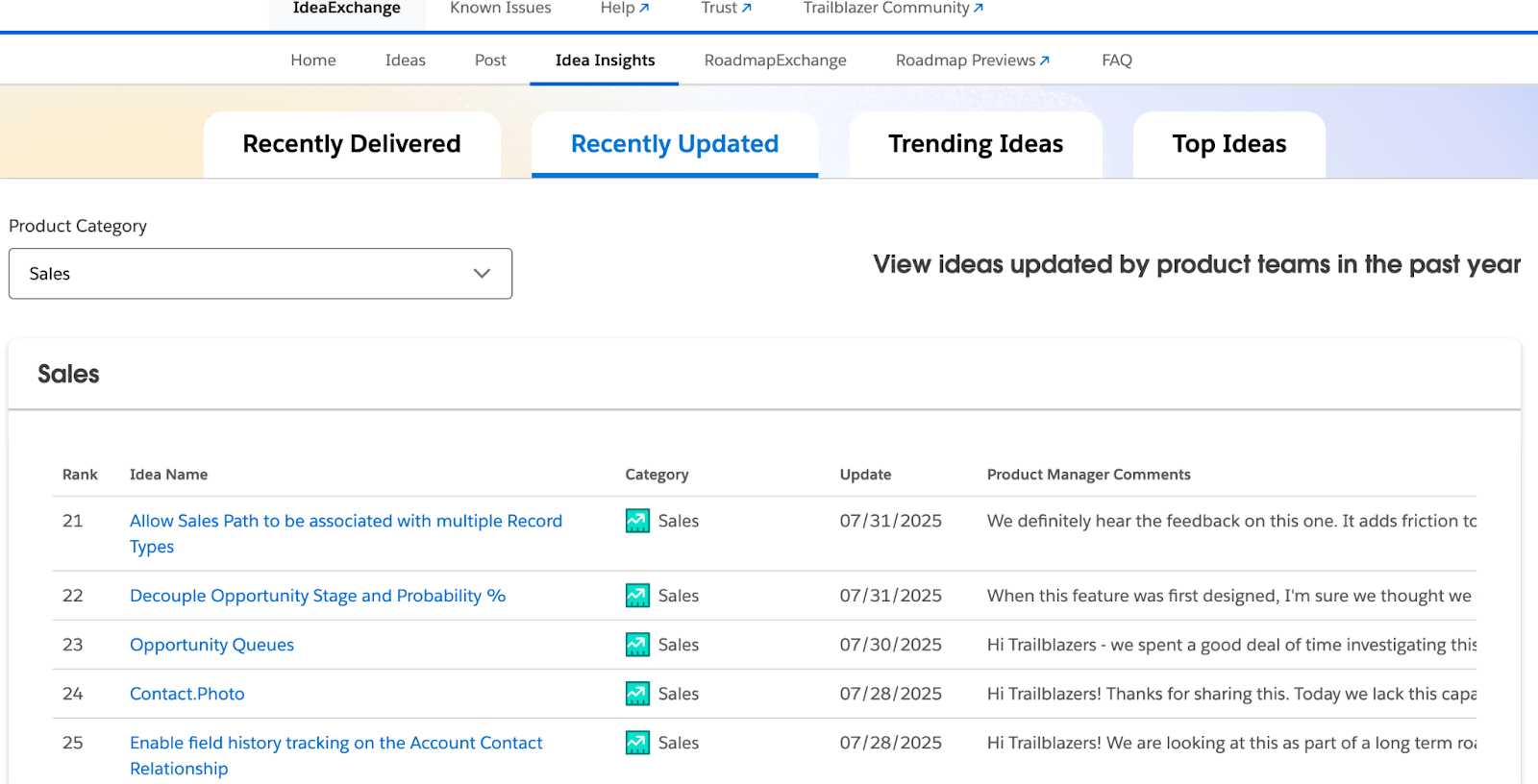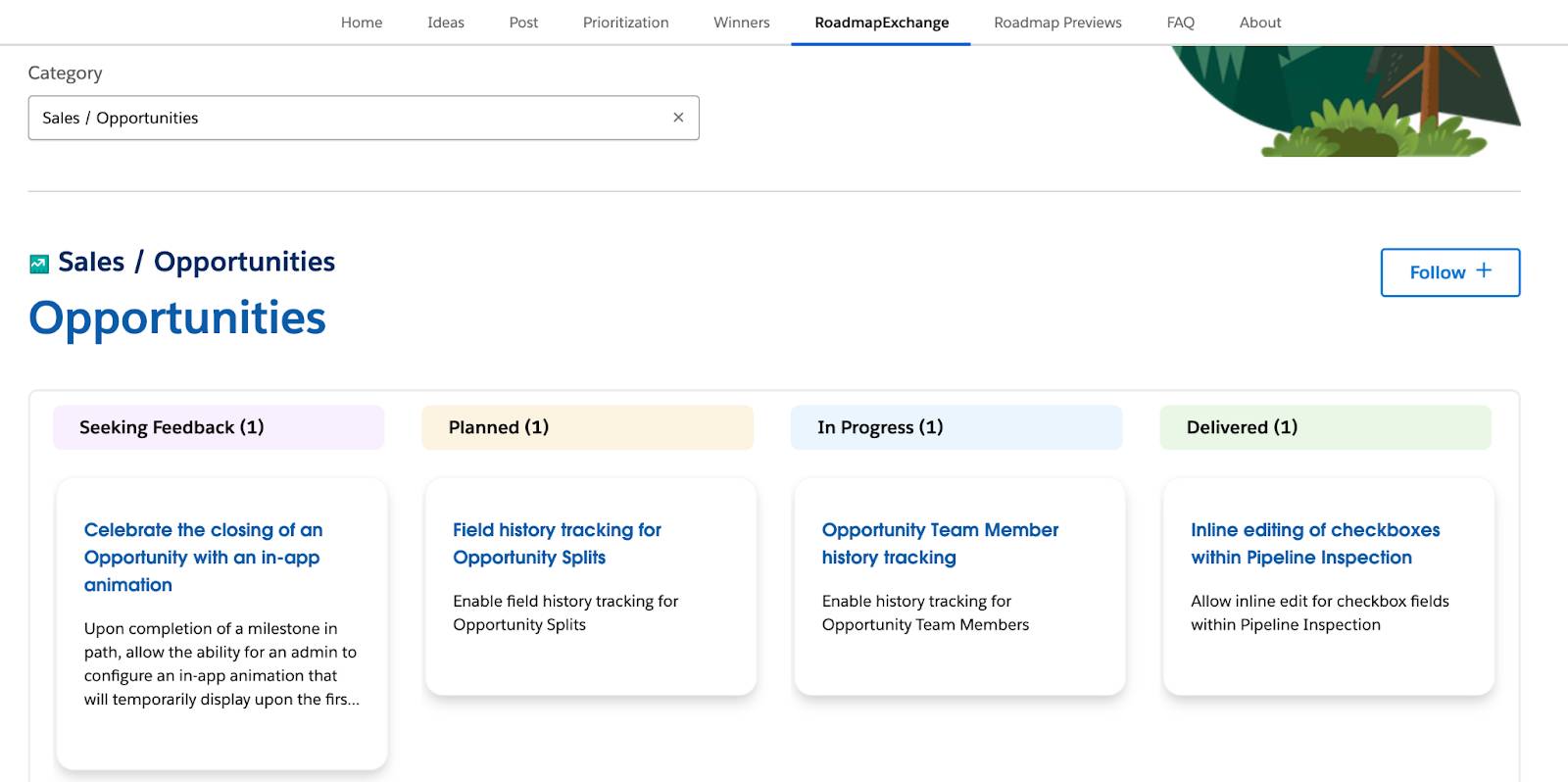Track Ideas for Upcoming Product Releases
Learning Objectives
After completing this unit, you’ll be able to:
- View ideas that have a recent pinned comment from Salesforce.
- Find status updates from Salesforce product managers for ideas.
- Describe what the different statuses mean.
- View ideas that have been recently delivered.
Hearing Back from Salesforce
Jose’s idea gained so much traction that it became one of the top ideas in Sales Cloud! Its rapid ascent caught the eye of the Salesforce product manager for Opportunities, who left a pinned comment on the idea. The comment let Jose and the community know that the idea is being considered for the roadmap and requested additional ideas for celebratory animations.
This makes Jose curious about which other ideas in Sales Cloud have received engagement from Salesforce recently. He navigates to Idea Insights, clicks on the Recently Updated tab and filters the Product Category by Sales.

Idea Insights
In addition to Recently Updated, Jose can also explore the following tabs on the Idea Insights page.
Trending Ideas
These are the ideas that have gained the most votes within the past year. This list allows our product managers to be more proactive by making it easy to determine which ideas are gaining traction and most relevant to Trailblazers.
Top Ideas
This is the all-time hall of fame for open ideas! This tab shows which outstanding ideas have gained the most votes overall since submission.
Recently Delivered Ideas
These ideas have been delivered in a recent release and are now live for you to check out in your org.
Check the Status of Ideas
As an idea moves through the release planning and development process (for example, when a team adds an idea to their roadmap), the product manager updates the status of the idea. If you’ve opted to receive notifications, you’ll know when this occurs.
Salesforce product managers update the status of an idea to communicate with you about where the idea stands. An idea is assigned one of the following primary statuses: Open, In Development, Delivered, or Archived. Each primary status is also assigned a secondary status, listed below.
Open
Open status means an idea is active. It has the following secondary statuses.
-
Submitted: This is the default status for all ideas.
-
Not Planned: This idea is viable but is not being considered for the roadmap within the year.
-
On Roadmap: This idea has been added to the product roadmap, with delivery expected within 3 releases.
-
More Information Required: This idea is vague and requires more information from the user who posted it.
In Development
This status means that active development for the idea has begun.
-
Building: This idea is currently being developed.
-
Beta Testing: This idea is currently in testing.
Delivered
This status means that the idea has been brought to market.
-
Complete: This idea as written has been released.
-
Partial: Some elements of this idea have been released.
Archived
This status means this idea has been closed and can no longer be voted on.
-
Never: This idea will not be considered in the future.
-
Merged: This idea has been merged with another idea.
-
Low Activity: This idea did not have enough engagement to keep it active.
-
Bug or Support Issue: This idea was part of a support issue and will not be considered in the future.
-
Retired Product or Feature: This idea is for a discontinued product or feature.
A Cause for Celebration
Jose notices that the Salesforce product manager updated the status of his idea. It’s now officially On the Roadmap! He goes to the RoadmapExchange section of the site, navigates to the Opportunities roadmap, and sees that his idea has been added to the roadmap. He can follow along there as well and provide further input to the product manager as his idea moves through the roadmap stages, which are: Seeking Feedback, Planned, In Progress, and Delivered.

Linda from Cloud Kicks also sees the status update on Jose’s idea. Knowing that it can take up to 3 releases to deliver an idea once it’s on the roadmap, Linda decides to provide Jose with a moment of instant recognition. She prints out a photo of an auditorium full of people clapping their hands and sticks it on Jose’s monitor while he’s at lunch. Jose smiles when he sees it. He knows that he and the community have helped shape Salesforce products, and that in a few releases, his sales reps will be smiling too as they celebrate their milestones in Salesforce.
Resources
